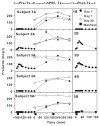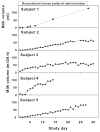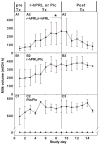Recombinant human prolactin for the treatment of lactation insufficiency
- PMID: 20718766
- PMCID: PMC6488522
- DOI: 10.1111/j.1365-2265.2010.03850.x
Recombinant human prolactin for the treatment of lactation insufficiency
Abstract
Context: Lactation insufficiency has many aetiologies including complete or relative prolactin deficiency. Exogenous prolactin may increase breast milk volume in this subset. We hypothesized that recombinant human prolactin (r-hPRL) would increase milk volume in mothers with prolactin deficiency and mothers of preterm infants with lactation insufficiency.
Design: Study 1: R-hPRL was administered in an open-label trial to mothers with prolactin deficiency. Study 2: R-hPRL was administered in a randomized, double-blind, placebo-controlled trial to mothers with lactation insufficiency that developed while pumping breast milk for their preterm infants.
Patients: Study 1: Mothers with prolactin deficiency (n = 5). Study 2: Mothers of premature infants exclusively pumping breast milk (n = 11).
Design: Study 1: R-hPRL (60 μg/kg) was administered subcutaneously every 12 h for 28 days. Study 2: Mothers of preterm infants were randomized to receive r-hPRL (60 μg/kg), placebo or r-hPRL alternating with placebo every 12 h for 7 days.
Measurements: Change in milk volume.
Results: Study 1: Peak prolactin (27·9 ± 17·3 to 194·6 ± 19·5 μg/l; P < 0·003) and milk volume (3·4 ± 1·6 to 66·1 ± 8·3 ml/day; P < 0·001) increased with r-hPRL administration. Study 2: Peak prolactin increased in mothers treated with r-hPRL every 12 h (n = 3; 79·3 ± 55·4 to 271·3 ± 36·7 μg/l; P < 0·05) and daily (101·4 ± 61·5 vs 178·9 ± 45·9 μg/l; P < 0·04), but milk volume increased only in the group treated with r-hPRL every 12 h (53·5 ± 48·5 to 235·0 ± 135·7 ml/day; P < 0·02).
Conclusion: Twice daily r-hPRL increases milk volume in mothers with prolactin deficiency and in preterm mothers with lactation insufficiency.
© 2010 Blackwell Publishing Ltd.
Figures




Similar articles
-
Effects of recombinant human prolactin on breast milk composition.Pediatrics. 2011 Feb;127(2):e359-66. doi: 10.1542/peds.2010-1627. Epub 2011 Jan 24. Pediatrics. 2011. PMID: 21262884 Free PMC article. Clinical Trial.
-
Usefulness of recombinant human prolactin for treatment of poor puerperal lactation in a rat model.Eur J Endocrinol. 1995 Nov;133(5):613-7. doi: 10.1530/eje.0.1330613. Eur J Endocrinol. 1995. PMID: 7581993
-
Growth hormone increases breast milk volumes in mothers of preterm infants.Pediatrics. 1996 Aug;98(2 Pt 1):279-82. Pediatrics. 1996. PMID: 8692630 Clinical Trial.
-
Domperidone for increasing breast milk volume in mothers expressing breast milk for their preterm infants: a systematic review and meta-analysis.BJOG. 2018 Oct;125(11):1371-1378. doi: 10.1111/1471-0528.15177. Epub 2018 Mar 27. BJOG. 2018. PMID: 29469929
-
Oral galactagogues (natural therapies or drugs) for increasing breast milk production in mothers of non-hospitalised term infants.Cochrane Database Syst Rev. 2020 May 18;5(5):CD011505. doi: 10.1002/14651858.CD011505.pub2. Cochrane Database Syst Rev. 2020. PMID: 32421208 Free PMC article.
Cited by
-
What Evidence Do We Have for Pharmaceutical Galactagogues in the Treatment of Lactation Insufficiency?-A Narrative Review.Nutrients. 2019 Apr 28;11(5):974. doi: 10.3390/nu11050974. Nutrients. 2019. PMID: 31035376 Free PMC article. Review.
-
The role of maternal care in shaping CNS function.Neuropeptides. 2013 Dec;47(6):371-8. doi: 10.1016/j.npep.2013.10.013. Epub 2013 Oct 24. Neuropeptides. 2013. PMID: 24210943 Free PMC article. Review.
-
The molecular basis of hypoprolactinaemia.Rev Endocr Metab Disord. 2024 Dec;25(6):967-983. doi: 10.1007/s11154-024-09906-9. Epub 2024 Oct 17. Rev Endocr Metab Disord. 2024. PMID: 39417960 Review.
-
Of SMN in mice and men: a therapeutic opportunity.J Clin Invest. 2011 Aug;121(8):2978-81. doi: 10.1172/JCI58752. Epub 2011 Jul 25. J Clin Invest. 2011. PMID: 21785213 Free PMC article.
-
A long-lasting prolactin stimulates galactopoiesis in mice.iScience. 2025 Jul 15;28(8):113112. doi: 10.1016/j.isci.2025.113112. eCollection 2025 Aug 15. iScience. 2025. PMID: 40792031 Free PMC article.
References
-
- Gartner LM, Morton J, Lawrence RA, et al. Breastfeeding and the use of human milk. Pediatrics. 2005;115:496–506. - PubMed
-
- Cumming RG, Klineberg RJ. Breastfeeding and other reproductive factors and the risk of hip fractures in elderly women. International Journal of Epidemiology. 1993;22:684–691. - PubMed
-
- Stuebe AM, Schwarz EB. The risks and benefits of infant feeding practices for women and their children. Journal of Perinatology. 2010;30:155–162. - PubMed
-
- Neifert M, DeMarzo S, Seacat J, et al. The influence of breast surgery, breast appearance, and pregnancy-induced breast changes on lactation insufficiency as measured by infant weight gain. Birth. 1990;17:31–38. - PubMed
-
- Neifert MR. Prevention of breastfeeding tragedies. Pediatric Clinics of North America. 2001;48:273–294. - PubMed
Publication types
MeSH terms
Substances
Grants and funding
LinkOut - more resources
Full Text Sources
Medical

